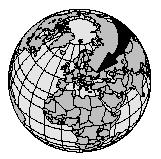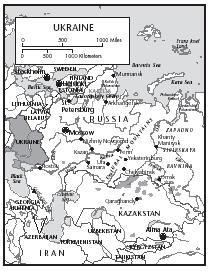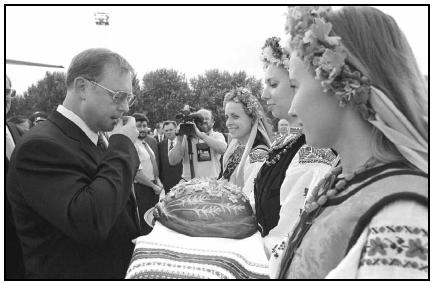Ukraine
Recipes

1 GEOGRAPHIC SETTING AND ENVIRONMENT
Ukraine is the second largest country in Europe. It is located between Poland and Russia. It is slightly smaller than the state of Texas. Much of the southeastern part of the country borders the Black Sea.
Most of Ukraine's land is made up of fertile plains, or steppes, and plateaus. Mountains are found only in the west and extreme south in the Crimean Peninsula. This area's climate is subtropical. Winters vary from cool along the Black Sea to cold farther inland. The temperature inland ranges from 66°F in July, to 21°F in January. Northern and western Ukraine average 27 inches of rainfall a year. This temperate climate is ideal for growing crops. In fact, more than 57 percent of the Ukraine's fertile soil is suitable for growing such crops as sugar beets, wheat, and potatoes.
2 HISTORY AND FOOD
The earliest known farmers in the Ukraine were the Trypillians (4500–2000 B.C. ). The territory of the Ukraine had rich soil and a favorable climate perfect for cultivating crops. The Trypillians grew barley, millet, rye, and wheat. They also herded sheep, pigs, and cattle. Wheat was plentiful, and soon trading routes were established along Ukraine's Black Sea coast to market the grain. The Ukraine territory became the crossing road connecting Arabia, Europe, and Asia.
Life depended on the activities of cultivating soil for crops. In pre-Christian times, holidays were celebrated during times of transition from one type of agricultural activity to another. These seasonal festivities were later incorporated into Christian holidays, such as Christmas and Easter.

Over time, Ukraine fell under the power of many different countries, including Poland, Austria, and Russia. Despite being under Russian domination for almost 200 years, (gaining independence only in 1991), Ukrainians proudly kept their native traditions, customs, and cuisine.
Kovbasa (sausage) and sauerkraut have Polish origins. Varnyky (dumplings) and holubtsi (stuffed cabbage) were originally imported from Turkey. Strudels, breaded meats, and desserts, such as cheesecake and tarts, were carried over from Austro-Hungarian times. Although Ukrainian dishes have origins from different countries, how they are prepared are uniquely Ukrainian.
Potato Varenyky (Potato Dumplings)
Ingredients
- 2 cups flour
- 1 egg
- 1 teaspoon salt
- 3½ cups instant mashed potatoes, prepared
- ¾ cup cheddar or processed cheese, shredded
- Salt and pepper, to taste
Procedure
- To make filling: prepare instant potatoes according to package directions.
- In a mixing bowl, add cheese and mix well. Set aside.
- In a large mixing bowl, combine flour, egg, and salt.
- Mix in a little water at a time until dough is stiff.
- Roll out dough on floured surface, about ¼-inch thick.
- Using the rim of a glass or cookie cutter, cut out circles of dough.
- Fill each circle of dough with about 1 Tablespoon of the potato-cheese mixture. Fold over and seal edges.
- To cook, bring a large pot of water to a boil and drop in the varenyky one at a time. They are done when they float to the top.
Serves 4 to 6.
3 FOODS OF THE UKRAINIANS
In the southern part of the Ukraine, plains called steppes have what is considered some of the most fertile soil in the world. Abundant rain and a mild climate made the Ukraine famous for its chornozem, or

Ukrainian cuisine stems from peasant dishes based on the plentiful grains and staple vegetables grown in the country. Staple crops include sugar beets, potatoes, grapes, cabbages, and mushrooms. These are often key ingredients in soups and salads. The most popular dish is borshch , a hearty soup made in a variety of ways, depending on the person who is cooking it. Mushroom, bean, and pea soups, and thick millet (a type of grain) chowders are also common. Other vegetable dishes include holubtsi (stuffed cabbage) and kartoplia solimkoi ("straw potatoes"). Kotlety Po-Kyivskomy (Chicken Kiev), a chicken breast stuffed with a buttery filling, is a well-known dish outside Ukraine.
Cabbage Borshch
Ingredients
- 3 cans beef broth (approximately 6 cups)
- 1 pound cabbage, shredded
- 1 beet, peeled and grated
- 1 medium onion, grated
- 3 medium tomatoes, diced
- ½ Tablespoon salt
- 1 teaspoon celery salt
- ½ teaspoon pepper (or more, to taste)
- 1 Tablespoons lemon juice
- 1 Tablespoon sugar
Procedure
- Measure the beef broth into a large pot. add the vegetables, celery salt, and pepper.
- Cover and cook over medium to low heat for 25 minutes.
- Add the lemon juice and sugar. Cook an additional 5 minutes.
- Serve with bread.
Serves 6.
Holubtsi (Stuffed Cabbage Rolls)
Ingredients
- ¼ pound ground beef
- 1 medium onion, chopped
- 4 Tablespoons vegetable oil
- 4 cups cooked rice
- 4 cups water
- Salt and pepper, to taste
- ¾ cup tomato juice
- 1 medium cabbage, core removed
- 1 Tablespoon vinegar
Procedure
- To make filling: cook rice according to package directions.
- In a frying pan, add the oil and heat over medium heat.
- Brown the onions and hamburger.
- Combine rice, onion, and hamburger in a mixing bowl. Season with salt and pepper. Set aside.
- Preheat oven to 350°F.
- In a large pot, bring the water and vinegar to a boil.
- Place the cabbage into the pot and simmer long enough for the cabbage leaves to become limp, about 5 to 10 minutes. Do not overcook.
- Remove cabbage and tear off cabbage leaves from the cabbage head.
- Remove the hard center part of the leaf.
- Place a spoonful of the rice mixture into the center of the leaf and roll tightly.
- Place cabbage rolls into a casserole dish and cover with the tomato juice.
- Bake for 1 to 1½ hours.
Makes 20 to 30 cabbage rolls.
Kartoplia Solimkoi (Deep-Fried Straw Potatoes)
Ingredients
- 4 medium potatoes, peeled
- 3 cups vegetable oil
- Salt, to taste
Procedure
- Cut the potatoes into small strips, about ⅛-inch thick.
- Drop them into a bowl of ice water, then drain.
- Spread out onto paper towels and thoroughly dry.
- Heat the oil in a deep frying pan over high heat. Drop small bunches of potatoes at a time into the oil and fry until golden brown.
- Drain on paper towels and season with salt.
Serves 4 to 6.
Grains, such as wheat, rye, barley, oats, corn, and buckwheat are cultivated and made into many different types of breads. Some examples are agnautka , a flat whole-grained loaf that is commonly eaten at meals; polianitsa , a large, round white bread; and ikrainka , a heavy, dark wheel-shaped loaf weighing about three pounds. Nachynka is a baked cornmeal side dish served with meat.
Nachynka (Cornbread Stuffing)
Ingredients
- 1 small onion, finely chopped
- 3 Tablespoons butter
- 1 cup cornmeal
- 1 teaspoon salt
- 1 teaspoon sugar
- ¼ teaspoon black pepper
- 3½ cups heated milk
- ½ cup half-and-half cream
- 2 eggs, beaten
Procedure
- Preheat oven to 350°F.
- In a frying pan, heat the butter over medium heat. Add onion and cook until tender, but do not brown.
- In a mixing bowl, combine cornmeal, salt, sugar, and pepper. Add to frying pan and mix well.
- Pour in the heated milk gradually and stir well until mixture is smooth and free of lumps.
- Add the eggs and mix well. Pour the mixture into a greased casserole dish.
- Bake the nachynka uncovered for 1 hour, or until golden brown.
Serves 6 to 8.
Kotlety Po-Kyivskomy (Chicken Kiev)
Ingredients
- 8 skinless, boneless chicken breasts
- 8 Tablespoons butter (1 stick)
- 1 Tablespoon parsley, chopped fine
- 2 eggs
- ½ cup flour (approximately)
- 1½ cups soft bread crumbs
- Vegetable oil for frying
Procedure
- Cut the butter into eight equal parts, each about the size of your little finger. (Cut the stick of butter lengthwise into quarters, and then cut the quarters in half crosswise.)
- Roll the butter rectangles in parsley to coat, and set them aside in a cool place.
- Place the chicken breasts, one at a time, between two sheets of wax paper, and pound them with a rolling pin or kitchen mallet until they are thin. Carefully remove the wax paper.
- Place one butter rectangle on each chicken breast, and roll the breast around the butter. Press the roll together to form a compact roll. Repeat until all 8 breasts have been rolled.
- Beat the two eggs lightly in a shallow dish. On a sheet wax paper, spread some flour; spread some bread crumbs on another sheet of wax paper.
- Dip the rolls first into the flour, then the eggs, and then the bread crumbs.
- When four rolls are done, heat some oil in a large skillet, and carefully add the rolls. Fry, turning several times, for about 15 to 20 minutes until the chicken rolls are golden brown and cooked through. Transfer to a serving dish, cover, and repeat with the remaining 4 rolls. (Keep the first batch warm in the oven set at the lowest temperature.)
Serves 8.
In Ukrainian cuisine, when the dough isn't baked, it is usually boiled, such as kasha (hot cereal), or fried in the form of dumplings or fritters. Freshly made dumplings called varenyky are a common Ukrainian staple. Varenyky is dough stuffed with a variety of foods, such as potatoes, meats, cheeses, sauerkraut, and even fruit, such as blueberries or cherries, for dessert. Each region, restaurant, and family has its own recipe.
The foothills of the Carpathian Mountains, located in the western Ukraine, provide pastures for grazing beef and dairy cattle. Meats, such as kovbasa (sausage), poultry, and pork are important to the Ukrainian diet.
Pork is considered the national meat and pork fat is often used in cooking. It is used mostly for frying, but also can be eaten smoked or with salt. Common dairy products include milk, syrnyky (cottage cheese fritters), nalynsnyk (cheese-filled crepes), and riazhanka (fermented, baked milk).
Desserts are often baked into sweet breads, cakes, and cookies, and made with honey and fruits, such as plums, blueberries, and cherries.
Dinner Menu for Sviaty Vechir (Christmas Eve)
Kutya (a type of wheat porridge)
Borshch (hearty vegetable soup)
Baked or fried fish
Oseledsi (pickled fish)
Holubtsi (cabbage rolls)
Varenyky (dumpling) with potato, sauerkraut, and prune filling
Cooked beans
Kapusta and peas (sauerkraut and peas)
Beets with mushrooms
Stewed fruit
4 FOOD FOR RELIGIOUS AND HOLIDAY CELEBRATIONS
Around 85 percent of Ukrainians are Christian. Therefore, the most important holiday in the Ukrainian church is Easter, followed by Christmas. Both holidays are celebrated according to the old-style Julian calendar, resulting in Christmas Day falling on January 7. Christmas Eve is called the Sviaty Vechir (Holy Evening). To celebrate, a ritual meal is traditionally prepared with 12 mostly meatless dishes, which symbolize the 12 apostles who gathered at the Last Supper. In some homes, the supper table is scattered with some hay, in memory of baby Jesus in the manger, with an elaborate tablecloth. Kolach is a traditional bread placed in the middle of the table. The meal usually begins with a small bowl of kutya , a mixture of cooked wheat, honey, poppy seeds, chopped nuts, and apples. This is followed by several fish dishes, mushrooms, holubtsi (stuffed cabbage), varenyky (dumplings), fruits, cakes, such as makiwnyk (poppy seed cake) and bread. Borshch (a hearty soup) is usually included as well.
Kutya (Sweet Porridge)
Ingredients
- 1 cup cream of wheat
- ¼ cup margarine or butter
- 2 cups water
- ¼ cup each honey, poppy seeds, and chopped nuts
Procedure
- Bring the water to a boil in a saucepan.
- Add the cream of wheat and chopped nuts. Stir until soft and the water is absorbed.
- Pour the mixture into a serving dish and add the butter and honey.
- Mix in the poppy seeds, saving a few for sprinkling over the top.
Serves 2.
Makiwnyk (Poppy Seed Cake)
Ingredients
- ¾ cup poppy seeds
- 1⅓ cup milk
- 2 Tablespoons cornstarch
- ⅓ cup oil
- ½ cup sugar
- 1 teaspoon vanilla
- ½ lemon or orange rind, grated
- 2 cups flour
- 1 teaspoon cinnamon
- 2½ teaspoons baking powder
- 2 Tablespoons lemon juice
- 1 Tablespoon sugar
Procedure
- Soak poppy seeds in milk for 1 hour in a large bowl.
- Preheat oven to 350°F.
- Add cornstarch, oil, sugar, vanilla and rind to the poppy seed-milk mixture and stir.
- In a separate mixing bowl, combine the dry ingredients.
- Add the dry ingredients to the poppy seed mixture and mix well.
- Pour into a greased cake pan and bake for 45 minutes.
- Top with glaze (see recipe).
Serves 6 to 8.
Makiwnyk Glaze (Poppy Seed Cake Glaze)
Ingredients
- 2 Tablespoons lemon juice
- 1 Tablespoon sugar
Procedure
- Add the lemon juice and sugar to a small saucepan and heat over medium heat.
- Stir gently until it forms a syrup.
- Drizzle over Makiwnyk.
A Ukrainian Easter meal also has its ritual foods. In the morning, breakfast foods such as hard-boiled eggs, kovbasa (sausage), baked cheese, breads, butter, and relishes, are placed into a basket and taken to church to be blessed. For Easter dinner, ham or roast pork, vegetable salads, cheesecake, tortes, and other pastries are eaten.
Besides Christmas and Easter, there are special breads for almost every important Ukrainian occasion. A bride and groom are blessed, and the dead remembered with kolach , a rich, intricate, braided bread, which symbolizes good fortune and eternity. For a typical wedding, seven bridesmaids grind flour from wheat grown in seven different fields to bake a korovai , a bread that symbolizes good luck. There are dozens of different ways of preparing and baking breads in the Ukraine.
5 MEALTIME CUSTOMS
In general, Ukrainians eat a light breakfast. It can be bread with butter served with coffee or tea, or pastries, such as a cream-filled blintz. Kasha (cereal), steamed buckwheat, barley, or millet with milk may also be served. Their main meal is eaten around mid-afternoon and usually consists of soup, such as borshch and a dish with meat or poultry. The third meal of the day takes place around 6 or 7 p.m. It is usually a time when all family members get together. Eating at a restaurant is considered a luxury, and is usually not done very often.
Ukrainians eat with a fork in their left hand and a knife in their right hand. It is considered impolite to hold your hands under the table during dinner, or to put your elbows on the table. In order not to seem wasteful, Ukrainians may eat everything on their plates. When they are visiting, Ukrainians may ask for second helpings to show appreciation for the food. Hosts often give guests a loaf of bread with salt on top, a tradition that dates back many centuries. Bread and salt were once considered necessary ingredients for health. The bread represents hospitality and the salt represents friendship.
6 POLITICS, ECONOMICS, AND NUTRITION
About one-third of Ukraine's land is used as pasture. Crops include sugar beets, potatoes, rye, and wine grapes. Before its independence, Ukraine was the most productive agricultural area in the Soviet Union. The land accounted for one-quarter of Soviet Union grain production, one-fifth of its meat and dairy, and more than one half of its sugar beet production. Farmers raise cereal crops, such as wheat and corn. Since its independence, Ukraine has suffered financially, resulting in high food prices, a shortage of medical equipment, and modern facilities, especially in rural areas. Despite having economic difficulties, most Ukrainians receive adequate nutrition. In fact, less than one percent of children under five are malnourished, and only 6 percent of children are too short for their age. Since Ukraine joined the World Bank in 1992, many different programs have been implemented to help the country's economy.
7 FURTHER STUDY
Books
Farley, Marta Pesetska. Festive Ukrainian Cooking. Pittsburgh, PA: University of Pittsburgh Press, 1990.
Zahny, Bohdan. The Best of Ukrainian Cuisine . New York, NY: Hippocrene Books, 1998.
Web Sites
Insider.com. [Online] Available http://www.sdinsider.com/community/groups/ukraine/Bread_and_Salt_Mean_.html (accessed April 22, 2001).
Ukraine—The Breadbasket and the Sugar Bowl. [Online] Available http://russia-in-us.com/Cuisine/Dadiani/ukraine.htm (accessed April 22, 2001).